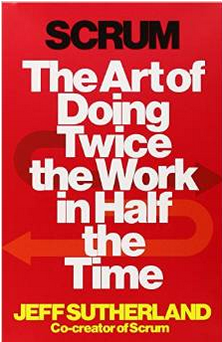I just finished reading “Scrum: The Art of Doing Twice the Work in Half the Time” by Jeff Sutherland.
The version of Scrum by Jeff Sutherland I read was an audio book actually narrated by J.J. Sutherland, who is Sutherland’s son. Scrum: The Art of Doing Twice the Work in Half the Time is a quick read or listen however you decide to do it. It’s a book that can be easily finished in a weekend.
It’s not a book that is going to tell you exactly all the details of running a Scrum team, but it gives the basics on how to start using Scrum. Most of the book is about why Scrum works and builds the case for Scrum for all projects.
Anyone reading this book will find it interesting and easy to read. Sutherland gives a brief history of Scrum’s origins and then goes into many real world examples of Scrum.
Scrum by Jeff Sutherland
Good:
- Several examples of Scrum working outside of Software Development.
- In depth talk how to build the case for Scrum in any organization.
- Great explanation on the of history of Scrum and how it was modeled after fighter pilot training.
- Opportunity to learn Scrum from one of the co-creators of Scrum.
Bad:
- Short book that left me wanting to hear more examples.
- Not a technical book about how to Scrum but a why to use Scrum book. I only say this for those experienced in Scrum looking for a technical book.
What I learned:
This book was great for giving me different ways to present the need for Scrum in an organization. As a ScrumMaster I always find myself selling Scrum to others inside and outside of my organization. This book will definitely give me more examples to talk about.
I learned new parts about the history of Scrum. Some of the history of Scrum I wasn’t familiar with was Jeff Sutherland’s career in the Air force. Jeff was a Top Gun and used much of his experience as a fighter pilot in the Vietnam War to create Scrum.
I would definitely recommend this book for any manager looking to improve his team’s performance. Scrum is well known in the software industry but the principles can apply outside of software development as laid out in this book. In fact the book goes into many examples of Scrum being used outside the software development industry.
While the book is for those without experience in Scrum, anyone interested in Scrum would enjoy. This is definitely a book you will want to pass around the office.
Let me know what you thought of the book.






